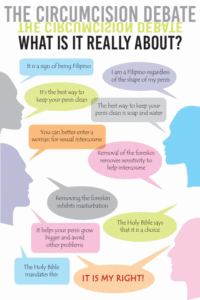WHAT IS THE DEAL WITH MALE CIRCUMCISION, CHILD SEXUAL ABUSE AND HUMAN RIGHTS?
The role of religion
IF YOU ARE A FILIPINO ADULT MALE, please share your experience with circumcision.
https://forms.gle/CpKFLNE1uZSWBJPe8
 Circumcision and child sexual abuse are not directly related. However, Center for the Prevention and Treatment of Child Sexual Abuse (CPTCSA) has an interest in how circumcisions are conducted when it is done during early pubescence for two reasons. First, because more young boys are sexually abused than girls in the Philippines, and second, because the penis plays an important part in sex and sexuality, and thus its abuse.
Circumcision and child sexual abuse are not directly related. However, Center for the Prevention and Treatment of Child Sexual Abuse (CPTCSA) has an interest in how circumcisions are conducted when it is done during early pubescence for two reasons. First, because more young boys are sexually abused than girls in the Philippines, and second, because the penis plays an important part in sex and sexuality, and thus its abuse.
In our previous post we referred to the common reasons given for circumcision around the world. These include cultural rites of passage for young adolescent boys, to the need for hygiene, to ability to have sex, and religion. Ultimately, we want to focus on the context of consent, and if boys really are given that right of consent. In this post we will talk a little about the role of religion in the practice of circumcision.
Let’s begin the process of giving consent with the context of full information about circumcision and the role that religion plays. While we don’t know everything that you might want to know, we can begin by giving you some links and hope that this leads to further links to help lead you to consent or decline to be circumcised, with a focus on religion and faith.
To begin, here is a brief outline from Jacqueline Smith: Male Circumcision and the Rights of the Child https://cirp.org/library/legal/smith/
In the Jewish community circumcision (brit milah) is a religious ritual and is usually performed on the child’s eight day of life by a Mohel. The rite of circumcision is one of the most ancient practices of Judaism. The commandment to circumcise male children was given to Abraham in the Torah (Genesis 17:7-14). Circumcision is (in general) a common denominator among movements: Reform, Conservative, Re-constructionist, Orthodox, all circumcise their male children and require male converts to undergo some form of circumcision. Anaesthetic is not used.
In the United States, the Jewish community has begun to question the practice, using arguments based on the religion. For instance, according to Jewish law, it is forbidden to hurt living things. Even the necessary causing of pain is considered cruel in Judaism. Also the fact that circumcision involves the surgical alteration of a perfectly natural God’s given part of the body, which stems from Jewish thought plays a role. The opinions range from supporting the view that a carefully considered decision against circumcision can be reconciled within Jewish tradition to the statement that the ritual of circumcision is one of the mistakes Judaism carries within it and should be considered not differently from the way they are considered by society in general, no matter how centrally important they seem to Jewish culture. Bringing a Jewish boy into the covenant symbolically in a ceremony officiated by a rabbi is an alternative proposed by some authors.
Religious circumcision is also practised by Muslims: the procedure is performed between the ages of four and 13 years. Curiously, however, the Koran contains no specific ordinance on this subject. However, according to the Sunnah (sayings and practices of the Prophet) circumcision is a sunnah for men and excision an honour for women. In the literature, also medical reasons are mentioned (removal of the prepuce under which impurities may gather and allow germs to spread and cause infection), and historic, pragmatic reasons. Also, within the Islamic doctrine, arguments against circumcision can be found, either based on the Koran itself, or on the Sunnah. However, these arguments are, to my knowledge, only used against female genital mutilation.
Within Christianity, male circumcision has no religious significance. Other religions and cultures practice male circumcision especially as a requirement for manhood within certain puberty rites.
Let’s talk more about circumcision in Christianity because of the high percentage of Christians/Catholics in the Philippines.
Speculation is that circumcision came to the Philippines both from the Islamic and Catholic beliefs. For many Christians, circumcision remains common because of the historical connection of both Christianity and Islam to Judaism. The circumcision of Jesus is celebrated as a feast day in the liturgical calendar of many Christian denominations. Jesus, after all, was Jewish and Jesus was circumcised.
In the Gospel, however, in the early days of Christianity, St. Paul asserted that physical circumcision was unnecessary for the salvation of Gentiles and their membership in the New Covenant. As St. Paul and other disciples spread the Christian Gospel around the world into cultures that did not circumcise their boys, they were left with the difficult question about if such men could convert. Some adult men did wish to be circumcised. But ultimately, St. Paul underscored the sufficiency of Christ’s sacrifice and the transformative power of faith, rendering physical circumcision unnecessary for salvation. The first Council of Jerusalem declared that circumcision was not necessary for new Gentile converts (as recorded in Acts 15). Covenant theology largely views the Christian sacrament of baptism as fulfilling the Jewish practice of circumcision, as both serve as signs and seals of the covenant of grace.
While historically circumcision is not observed by the majority of Christians in most parts of the Christian world, and mainstream Christian denominations neither require it for religious observance nor forbid it for medical or cultural reasons, it is practiced among some Christian countries and communities; about half of Christian males worldwide are circumcised, with most of them being located in Africa, Anglosphere countries (with notable prevalence in the United States), and the Philippines.
Before reading the 2 links below, I want to remind you about consent. In Acts15, you can read about the beginning of the conflict when some converted men did agree to be circumcised but many others did not, which began the debate among the early disciples. Those men who agreed to be circumcised to follow Jesus did indeed consent, in fact requested, circumcision. These adult men understood what the procedure entailed. They embraced the rationale. They consented.
You can go to Wikipedia for some quick answers: https://w.wiki/ERTX
If you are interested, here is something else to read and consider https://www.catholicsagainstcircumcision.org/the-morality-of-circumcision/
”What is the morality of circumcision? The Catechism of the Catholic Church teaches that amputations and mutilations performed on innocent people without strictly therapeutic reasons are against the moral law. Pope Pius XII taught that circumcision is morally permissible if it prevents a disease that cannot be countered any other way. In spite of these and other church statements against circumcision through the centuries, I’m told there is no strict Catholic rule against the practice today… [even though] no medical association in the world today any longer says circumcision is therapeutic.”
Here is a link for Evangelical Protestants https://christianity.stackexchange.com/questions/44086/what-does-colossians-211-mean-in-light-of-evangelical-protestant-soteriology
When you came to Christ, you were “circumcised,” but not by a physical procedure. Christ performed a spiritual circumcision–the cutting away of your sinful nature. Colossians 2:11 (NLT)
To help in your own understanding of the religious practice of male circumcision, talk with your parents, especially your father. And talk with your religious leader. In our next post we will talk about the non-religious reasons for circumcision.



 Each child’s survival story will be different depending on their age, gender, family, experience, and many other factors in their environment.
Each child’s survival story will be different depending on their age, gender, family, experience, and many other factors in their environment. This is an online game which can be played by a family with easily obtainable materials to help families recognize and talk about how they are adjusting to the new normal.
This is an online game which can be played by a family with easily obtainable materials to help families recognize and talk about how they are adjusting to the new normal. Patakarang pangkaligtasan para sa proteksiyon laban sa pang aabusong sekswal, ito ang tinatawag na Mga PATAKARAN SA PAGHAWAK
Patakarang pangkaligtasan para sa proteksiyon laban sa pang aabusong sekswal, ito ang tinatawag na Mga PATAKARAN SA PAGHAWAK This video introduces you to one form of prevention of sexual violence on children: Teaching personal safety to children/students, their teachers and their parents.
This video introduces you to one form of prevention of sexual violence on children: Teaching personal safety to children/students, their teachers and their parents. Mga magulang/ taga pag alaga, ang pag unawa sa ating mga damdamin at kung paano ang reaksiyon ng ating katawan dito ay mahalaga para sa ating kaligtasan.
Mga magulang/ taga pag alaga, ang pag unawa sa ating mga damdamin at kung paano ang reaksiyon ng ating katawan dito ay mahalaga para sa ating kaligtasan. Storytelling is an easy way to teach. CPTCSA has products to help families read to children to help them understand the concepts for personal safety and getting help. Click here to see and hear the story of Erika and Jay as they learn the touching rule. This book is also available on our website to purchase hard copies.
Storytelling is an easy way to teach. CPTCSA has products to help families read to children to help them understand the concepts for personal safety and getting help. Click here to see and hear the story of Erika and Jay as they learn the touching rule. This book is also available on our website to purchase hard copies. 